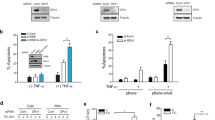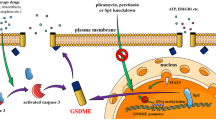Abstract
Human glutathione S-transferase P1-1 (GSTP1-1) is an ubiquitously expressed protein that plays an important role in the detoxification and xenobiotics metabolism. It has been shown that GSTP1-1 interacts with c-Jun NH2-terminal kinase (JNK) and suppresses its activity. Here, we report a novel function of GSTP1-1 in regulating tumor necrosis factor-α (TNF-α)-triggered signaling. The present experiments showed that GSTP1-1 physically associated with tumor necrosis factor receptor-associated factor 2 (TRAF2) in vivo and in vitro. Overexpression of GSTP1-1 inhibited TRAF2-induced activation of both JNK and p38 but not of nuclear factor-κB (NF-κB). Glutathione S-transferase P1-1 also attenuated TRAF2-enhanced apoptosis signal-regulating kinase 1 (ASK1) autophosphorylation and inhibited TRAF2–ASK1-induced cell apoptosis by suppressing the interaction of TRAF2 and ASK1. Conversely, silencing of GSTP1-1 expression through RNA interference (RNAi) resulted in increase of TNF-α-dependent TRAF2–ASK1 association followed by hyper-activation of ASK1 and JNK. A mutant GSTP1-1 lacking TRAF domain-binding motif exhibited a significant decline of capacity to bind TRAF2 and block TRAF2–ASK1 signaling compared with the wild type of GSTP1-1. Moreover, the glutathione-conjugating activity of GSTP1-1 was not involved in the regulation of TRAF2 signaling. These findings indicate that GSTP1-1 plays an important regulatory role in TNF-α-induced signaling by forming ligand-binding interactions with TRAF2, which provides a new insight for analysing the protective effects of GSTP1-1 in tumor cells.
This is a preview of subscription content, access via your institution
Access options
Subscribe to this journal
Receive 50 print issues and online access
$259.00 per year
only $5.18 per issue
Buy this article
- Purchase on Springer Link
- Instant access to full article PDF
Prices may be subject to local taxes which are calculated during checkout








Similar content being viewed by others
References
Adler V, Yin Z, Fuchs SY, Benezra M, Rosario L, Tew KD et al. (1999). EMBO J 18: 1321–1334.
Arch RH, Gedrich RW, Thompson CB . (1998). Genes Dev 12: 2821–2830.
Arch RH, Thompson CB . (1999). Annu Rev Cell Dev Biol 15: 113–140.
Ashkenazi A, Dixit VM . (1998). Science 281: 1305–1308.
Baud V, Liu Z, Bennett B, Suzuki N, Xia Y, Karin M . (1999). Genes Dev 13: 1297–1308.
Bradley JR, Pober JS . (2001). Oncogene 20: 6482–6491.
Chang LF, Karin M . (2001). Nature 410: 37–40.
Cho SG, Lee YH, Park HS, Ryoo K, Kang KW, Park J et al. (2001). J Biol Chem 276: 12749–12755.
Chung JY, Park YC, Ye H, Wu H . (2002). J Cell Sci 115: 679–688.
Cumming RC, Lightfoot J, Beard K, Youssoufian H, O'Brien P, Buchwald M . (2001). Nat Med 7: 814–820.
Davis RJ . (2000). Cell 103: 239–252.
Dorion S, Lambert H, Landry J . (2002). J Biol Chem 277: 30792–30797.
Fan Y, Wu D, Jin L, Yin Z . (2005). Cell Biol Int 29: 695–702.
Feldmann M, Maini RN . (2001). Annu Rev Immunol 19: 163–196.
Fessler MB, Malcolm KC, Duncan MW, Worthen GS . (2002). J Biol Chem 277: 31291–31302.
Gate L, Tew KD . (2001). Expert Opin Ther Targets 5: 477–489.
Gilot D, Loyer P, Corlu A, Glaise D, Lagadic-Gossmann D, Atfi A et al. (2002). J Biol Chem 277: 49220–49229.
Gotoh Y, Copper JA . (1998). J Biol Chem 273: 17477–17482.
Gotoh Y, Oishi K, Shibata H, Yamagiwa A, Isagawa T, Nishimura T et al. (2004). Biochem Biophys Res Commun 314: 688–694.
Hoeflich KP, Yeh WC, Yao Z, Mak TW, Woodgett JR . (1999). Oncogene 18: 5814–5820.
Hsu H, Huang J, Shu H, Biachwal V, Goeddel DV . (1996b). Immunity 4: 387–396.
Hsu H, Shu H, Pan MG, Goeddel DV . (1996a). Cell 84: 299–308.
Hsu H, Xiong J, Goeddel DV . (1995). Cell 81: 495–504.
Ichijo H, Nishida E, Irie K, ten Dijke P, Saitoh M, Moriguchi T et al. (1997). Science 275: 90–94.
Ichijo H . (1999). Oncogene 18: 6087–6093.
Kong KH, Nishida M, Inoue H, Takahashi K . (1992). Biochem Biophys Res Commun 182: 1122–1129.
Lee SY, Reichlin A, Santana A, Sokol KA, Nussenzweig MC, Choi Y . (1997). Immunity 7: 703–713.
Liu H, Nishitoh H, Ichijo H, Kyriakis JM . (2000). Mol Cell Biol 20: 2198–2208.
Lo H, Antoun GR, Ali-Osman F . (2004). Cancer Res 64: 9131–9138.
Locksley RM, Killeen N, Lenardo MJ . (2001). Cell 104: 487–501.
Lu M, Xia L, Luo D, Waxman S, Jing Y . (2004). Oncogene 23: 3945–3952.
Matsuzawa A, Saegusa K, Noguchi T, Sadamitsu C, Nishitoh H, Nagai S et al. (2005). Nat Immunol 6: 587–592.
Moscow JA, Fairchild CR, Madden MJ, Ransom DT, Wieland HS, O'Brien EE et al. (1989). Cancer Res 49: 1422–1428.
Natoli G, Costanzo A, Ianni A, Templeton DJ, Woodgett JR, Balsano C et al. (1997). Science 275: 200–203.
Nishitoh H, Saitoh M, Mochida Y, Takeda K, Nakano H, Rothe M et al. (1998). Mol Cell 2: 389–395.
Noguchi T, Takeda K, Matsuzawa A, Saegusa K, Nakano H, Gohda J et al. (2005). J Biol Chem 280: 37033–37040.
Park HS, Cho SG, Kim CK, Hwang HS, Noh KT, Kim MS et al. (2002). Mol Cell Biol 22: 7721–7730.
Park YC, Burkitt V, Villa AR, Tong L, Wu H . (1999). Nature 398: 533–538.
Pinkus R, Weiner LM, Daniel V . (1995). Biochemistry 34: 81–88.
Pinkus R, Weiner LM, Daniel V . (1996). J Biol Chem 271: 13422–13429.
Reinhard C, Shamoon B, Shyamala V, Williams LT . (1997). EMBO J 16: 1080–1092.
Rothe M, Sarma V, Dixit VM, Goeddel DV . (1995). Science 269: 1424–1427.
Rothe M, Wong SC, Henzel WJ, Goeddel DV . (1994). Cell 78: 681–692.
Ryoo K, Huh SH, Lee YH, Yoon KW, Cho SG, Choi EJ . (2004). J Biol Chem 279: 43589–43594.
Saitoh M, Nishitoh H, Fujii M, Takeda K, Tobiume K, Sawada Y et al. (1998). EMBO J 17: 2596–2606.
Shea TC, Kelley SL, Henner WD . (1988). Cancer Res 48: 527–533.
Smith CA, Farrah T, Goodwin RG . (1994). Cell 76: 959–962.
Song HY, Regnier CH, Kirsching CJ, Goeddel DV, Rothe M . (1997). Proc Natl Acad Sci USA 94: 9792–9796.
Takeuchi M, Rothe M, Goeddel DV . (1996). J Biol Chem 271: 19935–19942.
Tartaglia LA, Goeddel DV . (1992). Immunol Today 13: 151–153.
Tew KD . (1994). Cancer Res 54: 4313–4320.
Tobiume K, Matsuzawa A, Takahashi T, Nishitoh H, Morita K, Takeda K et al. (2001). EMBO Rep 2: 222–228.
Tobiume K, Saitoh M, Ichijo H . (2002). J Cell Physiol 191: 95–104.
Townsend DM, Tew KD . (2003a). Am J Pharmacogenomics 3: 157–172.
Townsend DM, Tew KD . (2003b). Oncogene 22: 7369–7375.
Townsend DM, Shen H, Staros AL, Gate L, Tew KD . (2002). Mol Cancer Ther 1: 1089–1095.
Voehringer DW, Hirschberg DL, Xiao J, Lu Q, Roederer M, Lock CB et al. (2000). Proc Natl Acad Sci USA 97: 2680–2685.
Wajant H, Pfizenmaier K, Scheurich P . (2003). Cell Death Differ 10: 45–65.
Wang T, Arifoglu P, Ronai Z, Tew KD . (2001). J Biol Chem 276: 20999–21003.
Xia P, Wang L, Moretti PAB, Albanese N, Chai F, Pitson SM et al. (2002). J Biol Chem 277: 7996–8003.
Xia ZP, Chen ZJ . (2005). Sci STKE 272: Pe7.
Xu L, Li L, Shu H . (2004). J Biol Chem 279: 17278–17282.
Xue B, Wu Y, Yin Z, Zhang H, Sun S, Yi T et al. (2005). FEBS Lett 579: 4081–4087.
Ye H, Wu H . (2000). Proc Natl Acad Sci USA 97: 8961–8966.
Ye H, Park YC, Kreishman M, Kieff E, Wu H . (1999). Mol Cell 4: 321–330.
Yeh WC, Shahiniam A, Speiser D, Kraunus J, Billia F, Wakeham A et al. (1997). Immunity 7: 715–725.
Yin Z, Ivanov V, Habelhah H, Tew KD, Ronai Z . (2000). Cancer Res 60: 4053–4057.
Yin Z, Liu A, Jiang Y . (2001). Acta Biochem Biophys Sin 33: 185–190.
Yuasa T, Ohno S, Kehrl JH, Kyriakis JM . (1998). J Biol Chem 273: 22681–22692.
Zhang R, Luo D, Miao R, Bai L, Ge Q, Sessa WC et al. (2005). Oncogene 24: 3954–3963.
Zhou L, Jing Y, Styblo M, Chen Z, Waxman S . (2004). Blood 105: 1198–1203.
Acknowledgements
We particularly thank Dr Ze'ev Ronai and Dr Zhenguo Wu for providing partial constructs used in this study, we also thank Huaqun Chen for technical assistance. This work was supported by grants from the Major State Basic Research Development Program of China (No. 2002CB513000) and National Nature Science Foundation of China (No. 30270527).
Author information
Authors and Affiliations
Corresponding author
Rights and permissions
About this article
Cite this article
Wu, Y., Fan, Y., Xue, B. et al. Human glutathione S-transferase P1-1 interacts with TRAF2 and regulates TRAF2–ASK1 signals. Oncogene 25, 5787–5800 (2006). https://doi.org/10.1038/sj.onc.1209576
Received:
Revised:
Accepted:
Published:
Issue Date:
DOI: https://doi.org/10.1038/sj.onc.1209576
Keywords
This article is cited by
-
NUMA1 modulates apoptosis of esophageal squamous cell carcinoma cells through regulating ASK1-JNK signaling pathway
Cellular and Molecular Life Sciences (2023)
-
Effects of different drugs and hormone treatment on Toxoplasma gondii glutathione S-transferase 2
Parasites & Vectors (2022)
-
GSTpi reduces DNA damage and cell death by regulating the ubiquitination and nuclear translocation of NBS1
Cellular and Molecular Life Sciences (2022)
-
GSTP1 as a novel target in radiation induced lung injury
Journal of Translational Medicine (2021)
-
FOLFIRI-Mediated Toxicity in Human Aortic Smooth Muscle Cells and Possible Amelioration with Curcumin and Quercetin
Cardiovascular Toxicology (2020)



